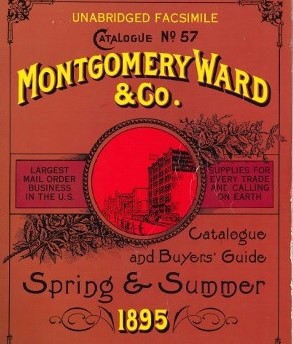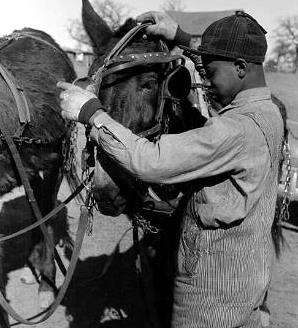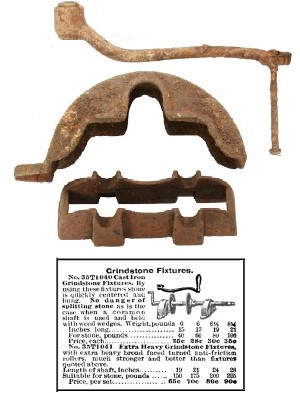This painting depicts a different set of farm-related activities occurring in the corral complex north of the house. Ransom built the massive rock walls to keep his cows and horses out of the fields, making use of the large limestone slabs in this rocky landscape. But the rock walls shift and sections sometimes topple over, so he added the wooden posts and barbed wire on top of the walls for additional security.
In this scene, Ransom, Will, and Charley are hitching up the team of horses and loading empty wooden barrels onto the wagon at mid-morning on a summer day. The farm has no well or cistern, so they regularly go down to Bear Creek to fill the barrels with water. A pond in the background catches rainwater runoff for the livestock to drink, but this pond goes completely dry during droughts. The sturdy “farm wagon” has seen heavy use, but Ransom knows how to repair it when anything breaks. He recently put on a new brake ratchet made by the Caldwell Wagon Company.
Like the wagon, the horse harnesses are well used and require constant repair. Ransom taught his boys how to work with leather and rivets, so he no longer has to do all of this work himself. Ransom and his boys are wearing their wide-brimmed work hats and overalls or suspenders, and Ransom is smoking his pipe as usual. While he occasionally uses snuff or chewing tobacco, Ransom prefers his smoking pipe. In the chest pocket of his overalls, Ransom carries a prized possession—his pocket watch.
A large drawknife is lying on the ground near the grinding stone where it was last sharpened. The knife is used to build and repair all types of wooden items, but most recently it was used to shave new staves used to repair broken water barrels. Ransom saves the broken iron hoops because he can easily reuse them, cutting them to the required size and adding new rivets. A hand-cranked whetstone for sharpening tools is stationed nearby, ready to put a sharp edge on the many farm tools.
Off in the distance, 10-year-old Mattie is feeding the pigs. Pork is one of the most important foods for the Williams family, and this is just one of many farm chores assigned to the kids. It's not one of Mattie’s favorite jobs, but she shares this responsibility with her older brother, Henry. A quantity of pig bones were found at the farm, along with chicken and rabbit bones, indicating these animals showed up at the Williams dinner table on numerous occasions.
The list of wagon parts and horse-related artifacts found at the farm and represented in this scene is impressive:
WAGON-RELATED ARTIFACTS (89 items)
Brake Shoe Iron
Chain Swivels
Clevises
Clevis Pins
Corner Iron
Forged Wagon Nuts
Iron Straps
Malleable Ferrule
Rivets
Wagon Box Side Board Brackets
Wagon Box Rod
Wagon Box Rod Collars
Wagon Box Staples
Wagon Box Straps
Wagon Box Strap Irons
Wagon Brake Lock
Wagon Brake Pawl
Wagon Seat Brace
Wagon Seat/Corner Iron
Wagon Wheel Hub
Wagon Wheel Nut Wrench
Wagon Wheel Rough Locks
Wagon Wheel Skein
Whiffletree Center Clips
Whiffletree End Clips
Whiffletree End Clip and Hooks
Whiffletree Hook
Whiffletree Strap
Whiffletree Tongue
HORSE TACK AND HARNESS EQUIPMENT (168 items)
Bolt Snap
Breast Strap Slides (fragment)
Bridle Bit, Ornate Snaffle (one half)
Bridle Bit, Plain Snaffle
Bridle Bits, Straight Bar
Bull Snap
Cinch Rings
Dee Ring
Harness Buckles
Harness Cockeye
Hook and Eye Fasteners
Horse Brand – Letter "R"
Horseshoe Nails
Horseshoes
Horseshoes (fragments)
Muleshoes
Metal Buckle (unidentified)
Metal Plate Buckle (unidentified)
Rivets (brass)
Rivet (copper or soft brass)
Rivet (iron)
Spur (brass, style 1)
Spur (brass, style 2)
Spur Fragments (iron)
Spur Fragments (iron, child's spur)
Strap Buckles
Tension Strap Buckle
Trace Buckle
|

Getting Water from Onion Creek. This photograph appeared in a 1916 report called: A Social and Economic Survey of Southern Travis County, along with the following caption: "Getting Water from Onion Creek: Cisterns are used to catch rain water for domestic purposes. When these are empty, water is hauled from the streams." Note the man and a water barrel in the back of the wagon. This is probably the same method Ransom Williams used to get water from Bear Creek for his family. Image from Haney and Wehrwein 1916.  |

Wagons, horses, and harnesses were important items at the Williams farmstead, as evidenced by the recovery of many wagon-related artifacts, horse tack, and pieces of harness equipment. Two references were particularly helpful for identifying these artifacts. One is the 1895 Montgomery Ward Catalog and the other is a book called A Historical Guide to Wagon Hardware & Blacksmith Supplies, which is a 1979 reprint of the 1909 catalog of the George Worthington Company of Cleveland, Ohio. Most of the wagon parts, horse tack, and harness items found at the farmstead are illustrated in these two catalogs.  |

Taken in 1940, this photograph shows "the son of Pomp Hall, a Negro tenant farmer, unharnessing a mule on his father's farm" in Creek County, Oklahoma. Even as late as the 1940s, horses and mules were still used to pull wagons and plows at many farms. At the Williams farmstead, we recovered many harness items and related horse-gear items that indicate just how important animal power was to their farming operation. Photograph by Lee Russell, Library of Congress, Prints and Photographs Division, LOC Call Number: LC-USF33- 012550-M3.  |

Grindstone fixtures found at the farm (depicted in the Frank Weir painting at bottom right). Enlarge to see full catalog page.  |
|




